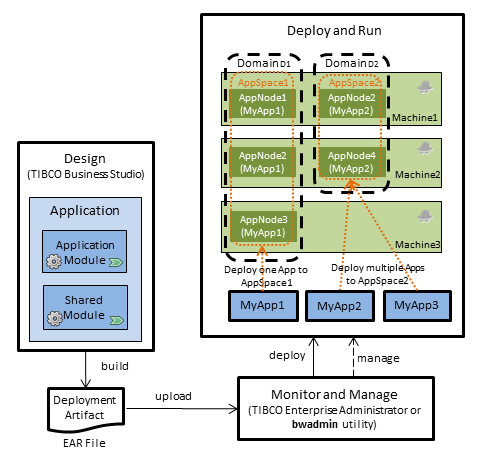Key Concepts
The following image provides an overview of the key concepts that you encounter when working with the product. Some of these concepts are applicable exclusively to design perspective or runtime and administration perspective, while some are applicable to both perspectives.
ActiveMatrix BusinessWorks™ consists of a design-time where you can develop applications that implement business logic, the runtime where you execute the applications, and the administration component where you deploy and manage applications in the runtime. The runtime is an ecosystem of entities that can be co-located or distributed. You can deploy, monitor, and manage the applications by using the bwadmin utility and TIBCO® Enterprise Administrator.
ActiveMatrix BusinessWorks™ is based on open architecture, flexibility, modularity, and support for standards.
Flexibility
TIBCO Business Studio for BusinessWorks is designed to make adding, upgrading, and swapping of business components easy.
The flexible architecture is demonstrated by:
- A zero coding model with which you can select and drop activities onto the Process Editor and configure the activities in the UI.
- Ability to build tightly coupled as well as loosely coupled services.
- Ability to build strongly typed as well as loosely typed service implementations.
- Ability to specify application configuration to be either hard-coded or late-bound.
- Ability to manage the process state that is maintained across invocations either by the runtime container (process engine) or by the process implementation.
- Encapsulation of configuration data, thus minimizing the configuration properties exposed by the application.
Openness and Extensibility
- Public APIs with which you can develop custom activities and XPath functions.
- Integration with standard Java classes and OSGi Java services to supplement the process or model driven approach.
- Extensible Eclipse-based design-time.
- Extensible OSGi based runtime.
- Extensible administration framework based on TIBCO® Enterprise Administrator.
Modularity
Modularity of the product supports:
- Large teams and distributed development through modular constructs.
- Increased visibility and traceability metadata, such as Name, Version, Exported Functionality, and Dependencies.
- Reusability with a consistent model across different technologies: Processes, Java Classes, XSDs, WSDLs, and shared resources.

